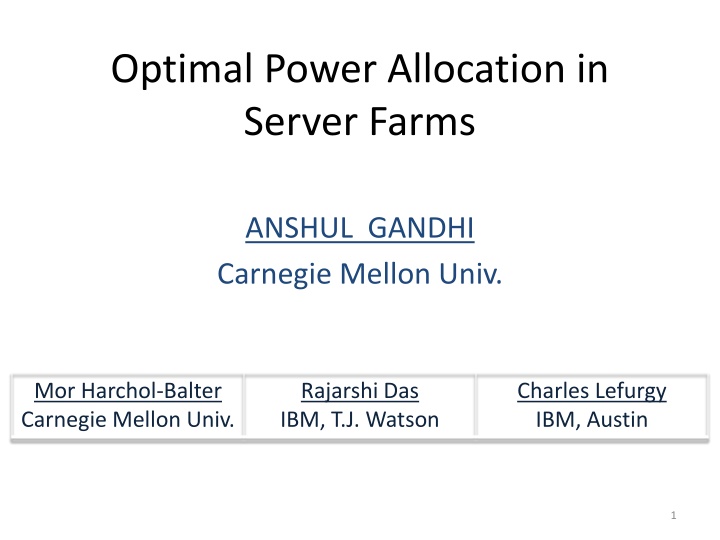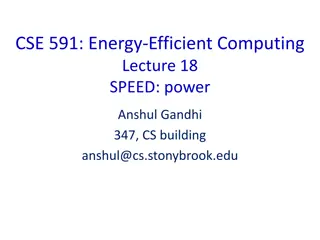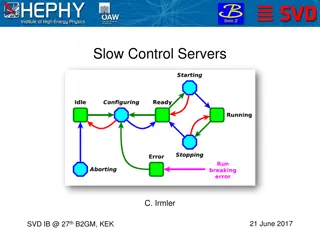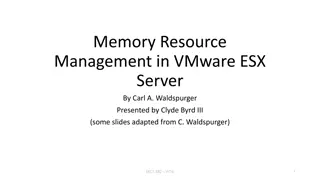Optimal Power Allocation in Server Farms: A Study on Efficiency and Performance
This research study delves into the optimal allocation of power in server farms to enhance performance and efficiency. It explores the impact of power on server speed, response time, and workload distribution. The results aim to provide insights on minimizing mean response time and improving overall server farm performance.
Download Presentation

Please find below an Image/Link to download the presentation.
The content on the website is provided AS IS for your information and personal use only. It may not be sold, licensed, or shared on other websites without obtaining consent from the author.If you encounter any issues during the download, it is possible that the publisher has removed the file from their server.
You are allowed to download the files provided on this website for personal or commercial use, subject to the condition that they are used lawfully. All files are the property of their respective owners.
The content on the website is provided AS IS for your information and personal use only. It may not be sold, licensed, or shared on other websites without obtaining consent from the author.
E N D
Presentation Transcript
Optimal Power Allocation in Server Farms ANSHUL GANDHI Carnegie Mellon Univ. Mor Harchol-Balter Carnegie Mellon Univ. Rajarshi Das IBM, T.J. Watson Charles Lefurgy IBM, Austin 1
U.S. Data Center Energy Consumption 120 billion kWh kWh (in billions) 100 80 50 billion kWh 60 $ 8.4 billion 40 12 billion kWh 20 0 2000 2006 2011 Source: EPA report to Congress on Server and Data Center Energy Efficiency ,2007 2
Goal Get the best performance from the power, P, that we have. Data Center P 3
Goal How to split P to minimize mean response time? Right answer can improve performance by up to 5X P1 P P2 P3 Constraint: P P1 + P2 + P3 4
Power Efficient Load Balancer Frequency = server speed Freq (GHz) Freq (GHz) Output Power (Watts) Power (Watts) q1 Input P P1 Speed scaling Workload Arrival rate Open vs. Closed Max speed Min speed . . P q2 POWER EFFICIENT LOAD BALANCER P2 P3 q3 5
Outline Experimental Setup Power Speed How power affects server speed for a single server Speed Response time How response time of server farm depends on individual server speeds Optimal power allocation Theorems and Experiments 6
Experimental Setup Blade Intel Xeon 5000 series 3 GHz, quad core 4 GB RAM Scaling tech. DFS, DVFS, DVFS+DFS Workload CPU bound (LINPACK, DAXPY) Memory bound (STREAM) Other (WebBench, GZIP, BZIP2) IBM BladeCenter HS21 Rack with 7 blade servers P1 P POWER EFFICIENT LOAD BALANCER P2 P3 7
Outline Experimental Setup Power Speed How power affects server speed for a single server Speed Response time How response time of server farm depends on individual server speeds Optimal power allocation Theorems and Experiments 8
Our Experimental Results How power affects server speed for a single server DFS: Dynamic Frequency Scaling s = + ( ) s s P P Frequency (GHz) min min (server speed) DFS linear P = system power NOT processor power s min P Power (Watts) P 9 min
Our Experimental Results How power affects server speed for a single server Frequency (GHz) Frequency (GHz) Frequency (GHz) DVFS DVFS +DFS LINPACK CPU BOUND DFS Power (Watts) Power (Watts) Power (Watts) Frequency (GHz) Frequency (GHz) Frequency (GHz) DVFS DVFS +DFS DFS STREAM MEM BOUND Power (Watts) Power (Watts) Power (Watts) 10
Outline Experimental Setup Power Speed How power affects server speed for a single server Speed Response time How response time of server farm depends on individual server speeds Optimal power allocation Theorems and Experiments 11
Pop Quiz High arrival rate 1. Given P = 720W and DVFS. Which allocation is better? a. 180|180|180|180 PowMin DVFS Results Response Time (sec) 240 x 3 15 b. 240| 240|240|0 PowMax 180 x 4 10 2. Given P = 720W and DFS. Which allocation is better? a. 180|180|180|180 PowMin 5 0 4 servers (720W) b. 240| 240|240|0 PowMax DFS Results Response Time (sec) 80 180 x 4 60 40 20 240 x 3 0 4 servers (720W) 12
Pop Quiz Low arrival rate 1. Given P = 720W and DVFS. Which allocation is better? a. 180|180|180|180 PowMin DVFS Results Response Time (sec) 15 b. 240| 240|240|0 PowMax 10 180 x 4 240 x 3 2. Given P = 720W and DFS. Which allocation is better? a. 180|180|180|180 PowMin 5 0 4 servers (720W) b. 240| 240|240|0 PowMax DFS Results Response Time (sec) 80 60 180 x 4 40 20 240 x 3 0 4 servers (720W) 13
Abstract Model of Server Farm Each server: Processor Sharing q1 s1 P1 P q2 POWER EFFICIENT LOAD BALANCER s2 P2 Poisson arrivals With rate jobs/sec s3 P3 q3 14
Response Time for Server Farm 1 1 1 = + + [ ] E T q q q 1 2 3 s q s q s q 1 1 2 2 3 3 (Mean Resp. Time) Non-linear in si and qi If :low PowMin results in poor utilization of some servers PowMin All server well utilized. Choice of PowMin vs. PowMax depends on scaling tech. PowMax PowMin If :high 15
Outline Experimental Setup Power Speed How power affects server speed for a single server Speed Response time How response time of server farm depends on individual server speeds Optimal power allocation Theorems and Experiments 16
Power Allocation Choices P servers power at P PowMin min DVFS P min Frequency (GHz) Ex: P = 720W PowMin = 4 X 180 DFS DVFS +DFS P servers power at P PowMax max P max Ex: P = 720W PowMax = 3 X 240 180 210 240 P servers power at P P PowMed P P knee knee max min P knee Ex: P = 720W PowMed = 3 X 210 17
Power Allocation Theorems OUTPUT INPUTS Optimal Power Allocation System Parameters linear steep PowMin Speed scaling technology linear flat Workload type THEOREMS PowMax cubic Pmin, Pmax < 0 Arrival rate: (2 regimes) 0 PowMed Open vs. Closed workload configuration 18
Power Allocation Results: Outline CPU bound LINPACK Memory bound STREAM DFS DVFS DVFS+DFS 19
Power Allocation Results CPU bound LINPACK Memory bound STREAM THEOREM THEOREM If If : : speed speed scaling scaling is is linear linear and and s s min min steep steep , , then then PowMax PowMax is is optimal. optimal. DFS P P min min DVFS DVFS+DFS Frequency (GHz) DFS min s Power (Watts) P 20 min
Power Allocation Results THEOREM THEOREM If If : : speed speed scaling scaling is is linear linear CPU bound LINPACK Memory bound STREAM s s min min and and flat flat , , then then P P DFS min min PowMax PowMax is is optimal optimal for for P DVFS PowMin PowMin is is optimal optimal for for P DVFS+DFS Frequency (GHz) DVFS . P Power (Watts) 21
Power Allocation Results CPU bound LINPACK Memory bound STREAM THEOREM THEOREM If If : : speed speed scaling scaling is is cubic, cubic, then then PowMax PowMax is is optimal optimal for for DFS 0 PowMed PowMed = is is optimal optimal ( max P for for 0 DVFS ) 2 P 3 3 P P P 0 min knee min P P DVFS+DFS max knee Frequency (GHz) DVFS +DFS Power (Watts) 0 22
Power Allocation Results DFS CPU bound LINPACK Memory bound STREAM Mean Resp. Time (sec) DFS DVFS DVFS+DFS Arrival rate (jobs/sec) DVFS DVFS+DFS Mean Resp. Time (sec) Mean Resp. Time (sec) Arrival rate (jobs/sec) Arrival rate (jobs/sec) 23
Conclusions: How to allocate power optimally Speed Scaling? Linear, Steep Linear, Flat Cubic Arrival Rate? Arrival Rate? Arrival Rate? High Low Low High High Low PowMax PowMax PowMax PowMin PowMax PowMed 24























